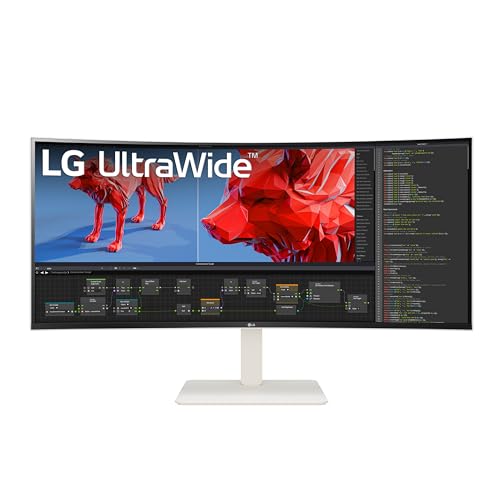Time flies when you’re no-lifing Baldur’s Gate 3, and just like that…. The R&D departments have been to work because we have some new.. EPIC.. Ultrawide Monitors to test and recommend. Take a look below.
In a Rush? Here’s Our List
- AOC CU34G3S 34" Frameless Curved Ultrawide Gaming Monitor, WQHD 3440 x1440,... — $407.85
-
Alienware AW3423DW Curved Gaming Monitor 34.18 inch Quantom Dot-OLED 1800R...
—
$779.95
$1,099.99 - BenQ PD3420Q Ultrawide Creator Monitor for Macbook 34" WQHD 1440p | 100%... — $799.99
-
SAMSUNG 49" Odyssey OLED G9 (G95SC) Series Curved Smart Gaming Monitor,...
—
$1,006.27
$1,799.99 - LG 38WN95C-W Monitor 38" 21:9 Curved UltraWide QHD+ (3840 x 1600) Nanio IPS... — $1,494.99
- Dell U4021QW UltraSharp 40-inch Curved WUHD Monitor — $1,799.99
Best Overall: Samsung Odyssey G9
The Samsung Odyssey G9 is the ultimate ultrawide monitor for gamers in 2024. Its 49-inch super ultrawide display with a 5120×1440 resolution and a 240Hz refresh rate delivers an unparalleled gaming experience. The 1000R curvature immerses you in the action, making it feel like you’re in the game. The G9 also features NVIDIA G-SYNC and AMD FreeSync Premium Pro support, ensuring smooth and tear-free gameplay.
Pros:
- Immersive 1000R curvature
- High refresh rate and resolution
- G-SYNC and FreeSync support
Cons:
- Expensive
- Requires a powerful GPU
Best Budget: AOC CU34G2X
For those on a budget, the AOC CU34G2X offers fantastic value. This 34-inch ultrawide monitor comes with a 3440×1440 resolution and a 144Hz refresh rate. It also has a 1500R curvature, providing a decent immersive experience for gamers. Despite its lower price, it still offers AMD FreeSync support to reduce screen tearing.
Pros:
- Affordable price
- 144Hz refresh rate
- Good resolution and curvature
Cons:
- Lacks G-SYNC support
- Build quality could be better
Best Curved: LG 38WN95C-W
The LG 38WN95C-W stands out with its impressive 38-inch curved display. With a 3840×1600 resolution and a 144Hz refresh rate, this monitor is perfect for immersive gaming and multitasking. It also supports NVIDIA G-SYNC and AMD FreeSync, making it versatile for different gaming setups.
Pros:
- Excellent resolution and refresh rate
- G-SYNC and FreeSync support
- Great for multitasking
Cons:
- Expensive
- Large footprint
Best Multitasking: Dell S3423DWC Curved
The Dell S3423DWC Curved is designed for gamers who need to multitask. Its 40-inch curved display with a 5120×2160 resolution and a 60Hz refresh rate makes it ideal for both gaming and productivity. It also comes with numerous connectivity options, including Thunderbolt 3, making it a versatile addition to any setup.
Pros:
- Large, high-resolution display
- Great for multitasking
- Multiple connectivity options
Cons:
- Lower refresh rate
- Very expensive
Best OLED: Alienware AW3423DW
The Alienware AW3423DW is the best OLED ultrawide monitor for gaming. Its 34-inch display with a 3440×1440 resolution and a 175Hz refresh rate provides stunning visuals and smooth gameplay. The OLED technology ensures deep blacks and vibrant colors, enhancing the gaming experience.
Pros:
- OLED display with excellent color accuracy
- High refresh rate
- G-SYNC support
Cons:
- Expensive
- Potential for burn-in with static images
Best for Productivity: BenQ PD3420Q
The BenQ PD3420Q is perfect for gamers who also need a monitor for productivity tasks. Its 34-inch display with a 3440×1440 resolution and a 60Hz refresh rate offers plenty of screen real estate for multitasking. It also features HDR support and excellent color accuracy, making it ideal for creative work.
Pros:
- Great for multitasking and productivity
- HDR support
- Excellent color accuracy
Cons:
- Lower refresh rate
- Not as immersive for gaming
FAQs
Q: What is the best refresh rate for gaming monitors? A: A refresh rate of 144Hz or higher is ideal for gaming, as it provides smoother motion and a better overall experience.
Q: Are curved monitors better for gaming? A: Curved monitors can enhance the gaming experience by providing a more immersive field of view, but it ultimately depends on personal preference.
Q: Do I need G-SYNC or FreeSync? A: G-SYNC (for NVIDIA GPUs) and FreeSync (for AMD GPUs) help reduce screen tearing and provide smoother gameplay. If your GPU supports it, having one of these technologies can enhance your gaming experience.
Q: What is the difference between OLED and LED monitors? A: OLED monitors offer better color accuracy and deeper blacks compared to LED monitors, but they can be more expensive and have a risk of burn-in with static images.
How We Test
To ensure we recommend the best ultrawide monitors for gaming, we conduct thorough testing on each model. Our testing process includes evaluating the following:
- Display Quality: We assess resolution, color accuracy, brightness, and contrast.
- Performance: We test refresh rates, response times, and input lag to ensure smooth gameplay.
- Features: We check for features like G-SYNC, FreeSync, HDR support, and connectivity options.
- Build Quality: We examine the monitor’s design, build materials, and ergonomics.
- Price: We consider the monitor’s price in relation to its features and performance to determine its overall value.
By following this rigorous testing process, we can confidently recommend the best ultrawide monitors for different gaming categories in 2024.

